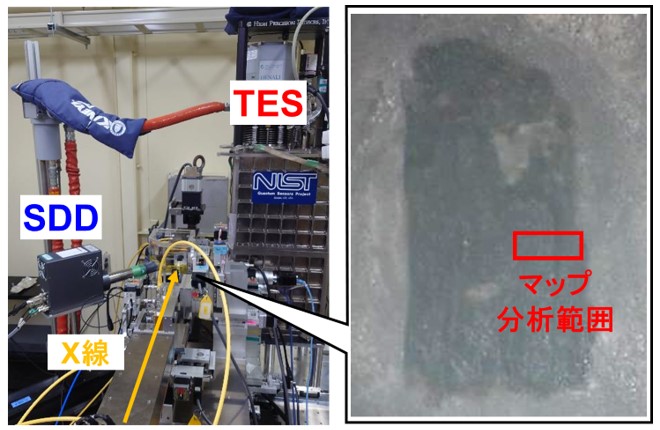DATE2024.04.09 #Press Releases
True distribution state of trace amounts of uranium visualized by superconducting technology
Disclaimer: machine translated by DeepL which may contain errors.
~ Expectations for Understanding the Migration Behavior of Various Trace Elements in the Environment ~
Rikkyo University
Japan Atomic Energy Agency (JAEA), School of Science The University of Tokyo
Tokyo Metropolitan University, Chubu University, RIKEN
International Center for Quantum Field Measurement Systems (WPI-QUP, KEK)
Osaka University, Okayama University, Meiji University
Japan Synchrotron Radiation Research Institute (JASRI)
Summary of Presentations
Understanding the migration behavior of uranium (U) in the environment, which is used as a fuel for nuclear power generation, is important for the safety assessment of radioactive waste during disposal. In order to accurately understand the migration behavior of U in the environment, a new analytical technique to detect only a small amount of U signal among many elemental signals in a sample has been desired.
Associate Professor Shinya Yamada, Faculty of Science, Rikkyo University; Professor Yoshio Takahashi, School of Science, The University of Tokyo; Research Scientist Takumi Yomogida, Japan Atomic Energy Agency (JAEA); Research Scientist Tomoya Uruga, Japan Synchrotron Radiation Research Institute (JASRI); Research Scientist Kiyofumi Nitta; Senior Researcher Oki Sekizawa, and their colleagues have developed a new technique to detect specific energy signals with high energy resolution. The TES is a superconducting transition edge sensor (TES) that can detect signals at specific energies with high energy resolution. This time, TES was applied for the first time in the world as a detector for fluorescence XAFS (X-ray absorption fine structure) analysis using microbeam X-rays at the BL37XU beamline of SPring-8, and succeeded in determining the distribution state of trace amounts of U in real samples, which cannot be detected with ordinary semiconductor detectors. This research has succeeded in understanding the distribution state of trace amounts of U in real environmental samples, which cannot be captured by ordinary semiconductor detectors.
This research enables the analysis of ultra-trace elements in environmental samples with micrometer-size spatial resolution, and is expected to be applied to research on the environmental migration behavior of various elements in addition to U, by clarifying the mechanisms of elemental migration behavior on the atomic and molecular scales.
TES is also being studied for various applications, such as cosmic X-ray observation, atomic and molecular, and nuclear physics, through instrument development and applicability research. With this achievement of nondestructive analysis of real environmental samples, TES is also expected to be widely applied to earth, environment, extraterrestrial samples and biological samples, such as nondestructive analysis of extraterrestrial samples obtained in future small celestial body sample return programs.
This research was published online on April 9, 2024 (16:00 JST) in Analyst, a journal published by the Royal Society of Chemistry, UK. 
Figure: (Left) Appearance of the experimental setup at BL37XU at SPring-8, (Right) Appearance of biotite materials used in the experiment and the scope of mapping analysis
For more information, please visit the website of Rikkyo University.(in Japanese)
Journals
-
Journal name AnalystTitle of paper


